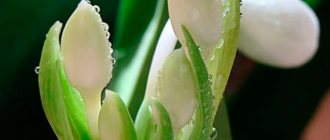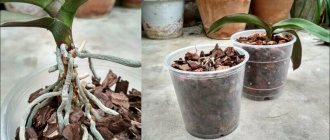Eucharis, also known as the Amazon lily, is a beautiful indoor plant that delights us with its white flowers. Its feature is also a pleasant smell during flowering, which not every type of indoor plant can boast of. However, not every caring owner can boast of regular flowering of the Amazon lily. Next, we will find out why eucharis does not bloom and what to do in this case.
When do the buds appear?
The Amazon lily blooms for the first time of the year in spring. The second flowering may occur in August or early September. However, experienced gardeners often achieve flowering in any other period.
You can tell that eucharis is ready to bloom by the presence of babies. If they appear, then you can expect flowers to appear soon. The main thing is not to plant young shoots in a separate pot.
The timing of the appearance of the first flowers in a young one may be affected by the method of reproduction:
- Eucharis is most often propagated by division. With this method of propagation, the young flower will be able to bloom in the second year of life.
- Eucharis can also be propagated by seeds. This process is longer and it will only take 5 years to wait for flowering.
The question of when eucharis blooms is discussed in more detail on this page .
Characteristics of the houseplant Eucharis
Eucharis is a bulbous plant belonging to the Amaryllidaceae family. In nature, it can be found in the forests of Central and South America.
The bulbs of an adult flower reach from 2 to 6 cm in diameter. The leaves are wide, lanceolate. They can grow up to half a meter in length. The plates are mounted on elongated petioles. The surface of the leaves is wrinkled and dark green in color. Eucharis growing in the natural environment can only have 2-4 leaves on one bush at a time. Indoor hybrids have an order of magnitude more leaves.
The decorative value of the plant is its flowers. The flowering period most often occurs in spring. The flowers resemble daffodils in appearance.
About 20 species of this plant are known. The following types are considered the most common:
- Large-flowered - blooms 3 times a year.
- White – blooms in March and September.
- Mastersa - blooms from March to May.
- Sandera - flowering from February to April.
- Toothless - blooms at the end of March.
- Amazonian - blooms in February.
Eucharis blooms with snow-white flowers with a pronounced pleasant aroma.
Reasons for lack of flowering. What to do if only leaves grow?
Why does the Amazon lily not bloom at home, but only produce leaves? First of all, you need to pay attention to the watering regime of the flower. A possible reason is overwatering and overfeeding the plant . As a result, eucharis cannot independently enter the resting phase and actively grows foliage. And since it is during the dormant period that flower buds are formed in the bulb, there is no need to expect any flowering.
Attention! The reason for the build-up of excess green mass can be fertilizers containing nitrogen. An excess of this mineral element leads to increased leaf growth and lack of flowering.
Beginning flower growers sometimes associate the lack of buds with the fact that there are few leaves on the bulbs. But their number has nothing to do with flowering (except in extreme cases when there are none at all). Under standard conditions, each bulb has three to four leaves.
The Amazon lily likes to be relatively cramped in a pot. It follows that eucharis does not need a spacious container. It has been noticed that the plant does not bloom until it grows with children and completely takes over the space. Therefore, you need to plant even 3-5 bulbs in one pot, so the plants will spend less energy on the development of the root part and will bloom faster.
Also, lack of flowering can be a direct consequence of improper care. We talked in detail about caring for this plant here.
Appearance of Eucharis
The plant consists of a bulb with a diameter of 2-7 cm, from which several wide (up to 20 cm) and long (up to 55 cm) lanceolate leaves of a rich green color grow. The surface is slightly shiny and the edge is slightly curved. Each bulb can bear no more than four leaves at a time. Total height - up to 80 cm.
Blooming eucharis
Most species and varieties bloom from August to September, but with good care they bloom a second time in February-March. The flower is very similar in appearance to a daffodil. The bulb produces a long (up to 80 cm) peduncle. At its end, from 3 to 10 large white flowers with a diameter of 10-12 cm can be collected into a common inflorescence. Different varieties have different sizes and shades of staminate filaments (from green to yellow). The aroma is very pleasant - jasmine-lemon. After blooming, each corolla lasts up to 10 days. When pollinated, flowers produce seed pods.
Note! The sap of the plant is poisonous, but moderately. Causes irritation upon contact with skin. If you eat the whole onion, it will cause indigestion.
Is it possible and necessary to stimulate the plant?
The flowering process is important for plants as it is the completion of the growing season. Plants bloom in order to be pollinated and reproduce. New young plants will appear from the formed seeds next year.
A plant may not bloom if it does not feel the need to reproduce. In this case, flowering can be stimulated by creating conditions of slight stress. We are talking about forced transfer of eucharis into a period of rest , by:
- reducing watering;
- moving to a less lit place;
- lowering the room temperature.
In this way, experienced gardeners can make the plant bloom even at unusual times. And it’s easier to do this indoors, since it’s easier to control watering, lighting and temperature.
On the other hand, it is not always worth stimulating flowering; there is a risk that a weakened plant may stop blooming altogether . Therefore, experts recommend simply following the rules for keeping eucharis at home, then it will bloom on its own 1-2 times a year.
Large spacious pot.
Most plants bloom in narrower pots, where they are a little cramped. This is how nature intended it: by releasing a peduncle, the plant tries to continue its genus by reproducing by seeds. In addition, in a large pot, the bulb will take longer to grow children, since it will need to grow many more children than in a narrow pot.
The solution to the problem is to be patient and wait until Eucharis has grown sufficiently and become bushy, or transplant the bulbs into a narrower pot.
What conditions are required for the natural process?
In order for the plant to feel comfortable and bloom independently, it is necessary to create conditions similar to those found naturally in their native environment.
Reference! Eucharis loves space and takes up a lot of space. It is best that no other plants are located near the pot. If the pot is on the windowsill, there is no need to place neighbors next to it.
Lighting
Under natural conditions, Eucharis is found in the lower layers of the rainforest, so it does not like direct sunlight . If you want to put a flower pot on the windowsill, it is better to let it be an east or west window.
Forcing
Forcing is understood as a set of measures to force eucharis to bloom at the right time. Among experienced flower growers, it is considered chic to force a plant to bloom for Christmas, New Year, or even for the birthday of a loved one. I will say right away that this is not an easy matter, requiring the adoption of radical measures.
First of all, stop watering and wait until the soil in the pot is completely dry. This usually takes a month. All this time, the pot with the indoor plant should be in a room where the air temperature is 15 degrees, no more. After this period, remove the bulb from the pot, wrap it in cellophane film, and place it in a thermos with water heated to 65 degrees. The bulb should remain there for 24 hours. Then plant it in a new, tight pot with new soil.
Place the pot in a room with an air temperature of 23-25 degrees. It should remain there until the flower stalks appear. Then the air temperature can be lowered to room temperature.
How to make an Amazon lily shoot out an arrow: step-by-step instructions
If the Amazon lily is not happy with its flowering, you can help it a little. To do this, you need to create special conditions and force the plant to retire :
- Move the plant to a darker place.
- Reduce the temperature to 15 0 C.
- Reduce watering the plant. Water only when the earthen ball dries out to two-thirds of the container.
- Be sure to stop any feeding.
After a month or two, the plant can be returned to its usual conditions. Usually, after taking these measures, eucharis blooms .
Eucharis is unpretentious in care and even a novice gardener can cope with its maintenance. By adhering to all the rules for caring for the plant, you can achieve effective flowering of eucharis every year.
The second, more popular name for eucharis is Amazon lily. This is one of the most unpretentious plants. That is, you need to try to prevent the eucharis from blooming. If this is your case and your indoor lily refuses to bloom, read my article.
Four reasons why eucharis does not bloom
1. The pot is too spacious. This is the most common reason. The thing is that eucharis (like any other plant) produces a peduncle in order to continue its genus. In a pot that is too wide, he feels very at ease, increases the leaf mass - and he does not at all need to worry about procreation, because nothing threatens him. But a cramped pot triggers a genetically inherent process aimed at reproduction - and the plant blooms.
Solution: transplant the plant into a narrower pot.
2. A small number of bulbs. Eucharis is a “family man” plant. As a rule, it begins to bloom if at least five bulbs sit nearby. Of course, there are exceptions to the rules and even one bulb can bloom, but this is a rare occurrence.
Solution to the problem: in this case, you will only have to wait until the eucharis starts a family.
3. Lack of a rest period is the second most common reason. In the Amazon lily, flower stalks are laid during the sleep period (this is about one and a half winter months). During this time, the plant should be placed in cooler conditions and watering should be kept to a minimum. Fertilizing at this time should also be excluded.
Solution to the problem: in the current season, you can try to stimulate the formation of buds using the drugs Bud, Pollen, etc., but this does not guarantee a 100% result.
4. Improper care conditions. It could be:
- lack of lighting (in this case it is necessary to change the location of the pot or organize additional lighting);
- the air is too dry (spray the plant more often and wipe its leaves with a damp cloth);
- drafts (change the location of the plant).
Features of Eucharis transplantation
Like all plants, the Amazon lily grows over time and acquires daughter bulbs. Naturally, such a “family” becomes cramped in the pot and requires a transplant. It is better to do this after the eucharis has faded, or in the spring, combining it with reproduction. Separate the bulbs carefully, trying to keep the earthen lump intact as much as possible. So the risk of damage to the fleshy roots will be minimal. The smallest children should be left on the mother's bulb, otherwise it may stop blooming for a while until it grows new offspring.
When caring for an indoor Eucharis flower, replanting should not be done too often. This is especially true when the bulb grows alone and does not want to multiply.
Only when she has a lot of children does the plant begin to bloom fully; besides, crowding only stimulates flowering. Eucharis can easily live for three years in one pot.
There are different opinions regarding what depth to plant eucharis. Some gardeners leave the top of the bulb above the ground, like hippeastrum. However, when planting bulbs with tiny children, the offspring are completely covered with soil. But this does not stop them from growing further. So you can safely fill in the eucharis, immersing the entire bulb in the ground. She will “push” everything that is needed to the surface herself. But if the bulbs do not have their own leaves, it is better to leave their tops above the soil.
How to care for eucharis at home
Eucharis Amazon lily care at home photo
Where to put the pot with eucharis
Eucharis does not like bright lighting. He prefers partial shade. Therefore, it is not advisable to place a flower pot with a plant on the southern windows. Lily will feel comfortable on an east or west window or on a shelf inside the room. In summer, the flower can be taken out into the garden or onto the balcony. Just first you need to prepare a special canopy for it, which will protect the plant from the rays of the sun and from rain.
Air humidity and temperature
In the room where the Amazon lily is located, for its active growth and flowering, it is necessary to maintain a temperature of 24º to 28º Celsius. At lower temperatures, its flowers become smaller. After flowering (in the resting phase), the flower is provided with a temperature range from 17º to 19º Celsius. If the room temperature drops to +10ºC or lower, the lily will begin to shed its leaves, and the plant bulb may rot.
It is not necessary to create special humidity in the room where the flower is located. It needs to be sprayed periodically and the leaves wiped off dust with a damp cloth.
During flowering, these manipulations should be performed with extreme caution. Water that gets on flowers can cause brown spots to form on them.
How to water eucharis
Moderate watering is considered optimal for the plant. In the case of the Amazon lily, they adhere to the following condition: “It is better to underfill than overfill.” Watering is carried out with settled water at room temperature. The excess water that remains in the tray of the flower pot is drained. The next watering during the growth period of the lily is carried out when the earthen ball dries out by a third of the volume, and during the dormant period, when the earth dries out, by half the volume.
What and how to feed Eucharis
To feed eucharis during the growing season, alternately use mineral and organic fertilizer complexes for plants in the flowering phase. They can be purchased at the store. The frequency of feeding is twice a month. During the dormant phase, the plant is not fed with fertilizers.
Common mistakes in caring for eucharis
Ignorance of the main requirements of cultivation plays a negative role in the development and growth of the Amazon lily. The home flower Eucharis requires proper care, and if agricultural practices are followed, it gives a luxurious appearance of green leaves and an abundance of delicate flowers.
If the leaves on Eucharis turn yellow and die one by one, this is a natural process. Yellowing of all leaves at the same time indicates problems with the plant such as:
- excessive or weak watering;
- low (less than +10ºC) room temperature;
- sunburn of leaves.
The plant can be “cured”. It is necessary to remove it from the pot and inspect the bulb for the presence of putrefactive zones. Cut off such areas, treat the cuts with ash, dry them and replant the plant.
- If the plant is left for a long time without watering, its leaves will become limp. Watering should restore the elasticity of the foliage. But if there is hypothermia due to a window being open in winter or transportation, the leaf turgor may not be restored.
- If the leaves of an Amazon lily curl and wither, then it is either sick in a draft or its roots are damaged.
Pests and diseases
With good immunity to pests, eucharis still sometimes suffers from thrips, scale insects and spider mites.
- Luffa at home: care and types
I won’t open America for you if I add that this only happens to plants weakened by improper care. You need to fight these insects with systemic insecticides (Aktellik, Fitoverm), which you will find in any flower shop, but it is better to prevent pest invasion by following the rules for caring for eucharis.
In the photo: Large eucharis flower
The most common disease that affects Eucharis is gray mold. The cause of the disease is high air humidity at low room temperatures. The first step is to reduce watering and treat the plant with preparations for gray rot - a solution of Bordeaux mixture, Champion or Topaz in case of mild infection. If severely damaged areas are found, they should be cut out to healthy tissue and the plant should be treated with copper-containing contact preparations - copper sulfate, cuproxate, oxychome.
Eucharis does not bloom
With proper care, eucharis blooms twice or even three times a year. But what to do if eucharis does not bloom for a long time? It is necessary to understand the reasons for this phenomenon.
In order to achieve rapid flowering, several eucharis bulbs are planted in one pot, because a single bulb will not bloom until it has acquired a large number of children, and this can only happen after 3-5 years. This is the most common reason why eucharis does not bloom for a long time. Other reasons are associated with improper eucharis content - drafts, temperature changes. Refresh your memory of the rules for caring for a plant, correct your mistakes, and the problem will resolve itself.
Pictured: Eucharis outdoors
How to make Eucharis bloom
Place the plant in a cool, shaded place for the winter, reduce watering, allowing the earthen ball to dry out almost completely, and stop feeding - this will be a good shake-up for the eucharis, which will begin to grow in the spring and will definitely bloom.
How to grow eustoma at home
Why does Eucharis turn yellow?
If just a couple of leaves turn yellow, it’s not a big deal. But if the number of yellow leaves increases and dark spots appear on them, then this is a bad sign. This happens because there has been a sharp change in the conditions of the plant - this is why the leaves of eucharis turn yellow: from drying out or waterlogging of the soil, from hypothermia of the plant.
In the photo: Eucharis in the garden
Eucharis leaves are falling off
If the leaves of Eucharis turn yellow and fall off, it is necessary to check the condition of its roots, remove rotten areas, treat the wounds with crushed coal and plant the plant in a new substrate. Keep the flower warm after transplantation, water it moderately and protect it from sunlight. If no rot is found in the roots, re-read the rules for caring for the plant and identify errors that could lead to this situation.
Reproduction of Eucharis by children
Reproduction of Eucharis by children photo
When growing a plant indoors, the easiest way is to use the vegetative method. Moreover, the Amazon lily has a large number of “children”. In March or April, they can be planted in separate containers with previously prepared soil.
An important point: only well-formed “babies” can be separated from the mother plant. Otherwise, the bulbous seed material will die.
Stress factor to stimulate flowering of Eucharis.
- Completely stop fertilizing and reduce watering to a minimum.
- Transfer the pot of Eucharis to a cool, dark place.
- Water the plant very rarely, only to maintain the viability of the bulbs.
- Leave the plant in this state throughout the winter.
- In early spring, transplant the plant into new soil without dividing the bulbs!
- Resume watering and return it to its original place - where there is good lighting.
As a rule, after applying such a stress factor to a plant, it begins to quickly and actively produce flower stalks.
Eucharis is a beautiful flower from the humid American forests. It first came to Europe at the beginning of the 19th century. Delicate eucharis quickly found its niche in garden and indoor floriculture. His popularity continues to grow. The flower can also be found under the name Amazon Lily. This definition is due to the high concentration of this culture in the Amazon. It is associated with lilies with lanceolate leaves and a delicate aroma.
When and how to replant eucharis
Amazonian lily does not like transplants. Therefore, if the plant is healthy, blooms well and does not fall out of the flower pot, it can not be disturbed for three to four years.
A healthy flower is transplanted when many “children” have been formed and they interfere with the normal growth of the flower.
The daughter material can be used to propagate the plant, or it may not be separated from the mother flower. In the latter case—transplanting into renewed soil without separation—you can achieve more luxuriant flowering of the lily.
March is the most favorable month for replanting a plant. A healthy plant is transplanted into prepared soil using the transshipment method, without disturbing the earthen coma.
If the flower bulbs are rotten, they are carefully removed from the soil and washed with water. Then the rot is removed (cut). The cut surface is thoroughly disinfected by immersing it in a fungicide solution. Then sprinkle the cut with wood ash.
Depending on the initial planting material (bulb with and without leaves), there are two options for planting the plant.
Planting Amazon lily with leaves
How to plant eucharis photo
Leaves are not trimmed before planting, only those that are yellowed and dying are removed.
- Planting depth - 5-6 cm.
- The container for planting is tall, not wide, with a hole in the bottom and drainage at the bottom made of expanded clay or small pebbles.
- Watering is moderate for the first 3 weeks, as the soil dries.
- The location is bright and warm.
Planting an Amazon lily without leaves
Before planting, the leaves are completely cut off at a height of 1 cm above the bulb.
- Planting depth - the top of the bulb looks 0.5 cm above the soil surface.
- The container for planting is 2-3 cm larger in diameter than the diameter of the bulb.
- The soil is half sand.
- Watering is moderate for the first three weeks, as the soil dries.
- The location is bright and warm.
If you planted an Amazon lily bulb without leaves, the plant will grow new leaves approximately 40 days after planting. The fact that the top of the bulb is above the surface of the ground will make it easy to observe the growth and development of the plant.
Soil and primer for eucharis
In its homeland, eucharis grows in a loose substrate rich in organic matter. As a potted crop, a ready-made store-bought substrate for amaryllis will suit it.
You can also make fertile and light soil yourself by mixing:
- 2 parts leaf soil;
- 1 part each of sand and humus;
- 0.5 parts peat.
As a bulbous plant, eucharis needs good drainage to prevent rotting of the root system. Be sure to add expanded clay or small stones to the bottom of the pot.
When choosing a flowerpot for a lily, you should take into account the fact that it grows a decent-sized foliage rosette. Therefore, you should give preference to heavy ceramic pots that will not tip over under the weight of the plant. However, you should not use too large a container, otherwise the first flowering will not come soon. The exception is group planting - then a wide bowl is ideal for several bulbs.
What if the purpose of planting is not flowering, but reproduction? When asked why eucharis does not produce children, many practicing flower growers advise, on the contrary, to plant it in a spacious pot. They say that tight dishes stimulate flowering, and wide ones stimulate reproduction. Try checking.
Earth for eucharis
Eucharis flower care at home Houseplant eucharis photo
Eucharis loves fertile soil with good water and breathability.
The most convenient way is to purchase special soil in a store. You need to choose soil marked “For plants of the amaryllis family.” If this is not possible, you can prepare it yourself by mixing the following ingredients:
- humus 1 share;
- leaf soil 2 shares;
- river sand 1 share;
- peat 0.5 shares.
The plant must be provided with drainage from coconut shells, expanded clay, and small stones. It will remove excess moisture.
Signs and superstitions associated with eucharis
The Amazon Lily protects women from various troubles, including the evil eye and damage. In the homeland of eucharis, it is customary to decorate the bride with it. It is believed that a flower in the hair blesses a girl for a happy family life and becomes a talisman for newlyweds. The additional presence of eucharis in a wedding bouquet will only enhance the effect of the amulet.
The following signs and superstitions are associated with the plant:
- If a lily suddenly withers, it means that someone in the family has been damaged. The plant takes on all the negative energy and dies.
- The appearance of a peduncle with three flowers predicts pregnancy. The third bud symbolizes the baby.
Eucharis does not bloom
- If eucharis does not bloom, you need to carefully analyze family relationships. The absence of flowering indicates a tense atmosphere at home.
Growing a flower is welcome in families with small children. It is believed that it contributes to the development of the child’s mental abilities and talents. There is a belief that the flower absorbs children's fears, calming the little ones. But you should remember that eucharis is poisonous, so you should not allow your child to touch it.
Feng Shui recommends this plant as a powerful generator of positive energy. According to Taoist practice, it absorbs negative sha energy, transforming it into beneficial qi.
The plant has a positive effect on marital relationships and eliminates conflicts between parents and children. It has especially powerful energy during flowering. During this period, he is able to drive away depression, uncertainty, apathy, laziness and gloomy thoughts.
Why eucharis does not bloom at home and how to make it bloom
Why Eucharis Doesn't Bloom Home Care Rules
Provide the plant with proper care, and it will delight you with beautiful, fragrant flowers two or three times a year. The lily's flowers open one at a time and bloom for up to ten days each. Gardeners can create an artificial watering and fertilizing schedule for the lily, which will ensure that the plant blooms multiple times throughout the year.
Proven watering and fertilizing schedule:
- January + 1st half of February = rest period
- 2nd half of February + 1st half of March = active growing season
- 2nd half of March + 1st half of April = flowering phase
- 2nd half of April = active growing season
- May + 1st half of June = rest period
- 2nd half of June + 1st half of July = active growing season
- 2nd half of July + 1st half of August = flowering phase
- 2nd half of August = active growing season
- September + 1st half of October = rest period
- 2nd half of October + 1st half of November = active growing season
- 2nd half of November + 1st half of December = flowering phase
- 2nd half of December = active growing season
Why doesn't Eucharis bloom? Errors in care video
Sometimes the plant does not bloom even though it seems to be in optimal conditions.
This means the gardener made a mistake. Here are the most common:
- Incorrect landing. The young plant is planted in a wide container, the diameter of which is many times greater than the diameter of the bulb. The tighter the plant is in the pot, the faster it will bloom.
- Sudden change in room temperature. The plant will form weak flower arrows or its bulb will rot, and flowering will not occur if the eucharis is constantly in a draft and in a state of stress.
- The resting phase has not been maintained. It should last about a month and a half. During this period, the plant is not fed and watered rarely. The lump of earth should be half dry. This is checked using moisture indicators, wooden sticks or the weight of the pot. During the dormant period, the plant needs to have good lighting.
Problems with the plant
Eucharis does not bloom! What to do? This is not a question, but simply a cry from the soul of those amateur flower growers who have already despaired of seeing their lily bloom (the question “fuchsia does not bloom: what to do?” is imbued with no less drama). And this stubborn beauty can stubbornly sit in her pot for years and not give the slightest hope for flowers to appear.
Lack of flowering may indicate errors in maintenance. Eucharis may not bloom for the following reasons:
1. The plant is planted in a pot that is too spacious. The fact is that eucharis does not need a very spacious container and will not bloom until its roots completely entwine the earthen ball. Being planted in a very spacious pot, eucharis will spend all its energy not on flowering, but on enlarging the bulb and root system.
2. The bulb has not yet reached the required size, allowing it to produce several daughter plants (children) and bloom.
3. The plant is not provided with a period of rest (the Amazon must retire twice a year). During this time, the plant accumulates the strength it needs to bloom.
Getting buds to appear
If you have several eucharis bulbs at your disposal, plant several of them at once (at least three) in one pot. With the beginning of the growing season, they will quickly occupy the entire volume of the container, which will provoke a rapid onset of flowering.
If there is only one bulb, you should plant it in a small pot. The gardener will have to stock up on the patience necessary for the plant to grow and have children. It is the appearance of daughter plants in a flower pot that is evidence that eucharis is quite ready to flower.
The plant needs to be provided with a dormant period twice a year (in February and at the end of summer). At this moment, the plant is transplanted into a new pot (leaving a few bulbs in it), practically stopping spraying, watering and any kind of fertilizing. The maximum air temperature in a room with a resting eucharis should not exceed 18 degrees.
At the same time, drafts and sudden temperature changes are unacceptable. Two months later, the pot with the rested lily must be brought into a warm room, starting with abundant watering and regular feeding.
A sharp contrast in conditions will certainly give impetus to the formation of powerful flower stalks, and the plant will certainly delight its owner with abundant flowering. For autumn flowering, a similar algorithm of actions should be repeated at the end of August.
Eucharis diseases
Gray rot
This disease is often found in plants of the amaryllis family, which includes the Amazon lily. The causative agent of the disease is the fungus Botridis. Plants located in damp rooms with low temperatures are susceptible to the disease. First, the leaf plates of the affected flower soften, lose turgor and darken at the edges. Then the infected areas are covered with gray mold and they die.
Prevention measures: removal of infected areas of the plant, treatment of the flower with products containing copper (copper sulfate solution, Fundazol, Topsin-M).
Stagonosporosis (red burn)
Plants located in rooms with sharp temperature fluctuations or waterlogged plants are susceptible to the disease. First, oblong red spots appear on the leaves, buds, and bulbs. Then the leaves wither, the flower stalks and buds bend and bend down, and the bulbs rot. Eucharis withers and dies.
Preventive measures: use of high-quality bulbous material for planting, treating the bulbs with a fungicide before planting for half an hour (Rovral, Oksifom, Maxim) and subsequent drying (48 hours).
What to do if eucharis does not bloom due to pests
Diseases and harmful insects greatly affect the Amazon lily's ability to bloom. A diseased plant may not only refuse to bloom, but over time the disease usually leads to its death.
Pests also happily settle on these flowers, causing a lack of budding, yellowing and falling of the foliage, and eventually the death of the eucharis. The most common diseases affecting the Amazon lily are the following fungal diseases: root rot, leaf rot and red burn.
The cause of root rot is excessive and prolonged soil moisture.
The fungus develops in a moist environment and penetrates the root system through mechanical damage or dead areas. In the early stages, root rot is not visible. Later, Eucharis begins to lose leaves. They turn yellow and wither en masse.
Plants can be treated only in the early stages of damage. In this case, replanting into new soil helps. The affected roots are removed. For preventive purposes and to destroy the fungus, the plant is watered at the root with antifungal drugs.
Leaf rot affects leaves when water gets into their axils. The fungus looks like a gray mold that covers areas of leaves and spreads quickly. When fighting leaf rot, all affected leaves are removed, and the plant is treated with antifungal drugs on top. For preventive purposes, you need to ensure that when spraying, less water gets on the leaves and dries out.
Red burn is a disease in which red spots of various configurations appear on the bulbs and leaves.
Peduncles grow ugly, and eucharis flowers do not bloom. No treatment has been developed. It is recommended to destroy diseased plants. When planting bulbs for preventive purposes, it is recommended to soak them in antifungal solutions.
Of the common pests of indoor plants that can live on eucharis:
- Red spider mite;
- Shchitovka;
- Thrips;
- Amaryllis mealybug.
If insects are detected, the plant must be immediately treated with insecticidal preparations.
Pests
Fungus gnat (sciarids)
Black midge. Its females place eggs directly on the root of the plant. The larvae that emerge from the eggs feed on the root tissues and inhibit it. The result is a weakened, non-flowering plant.
The reason for the appearance of midges is waterlogged soil in a flower pot.
Preventive measures: Treatment (watering) of the soil with Oktara solution at the rate of 0.8 g per liter of water, adjusting the frequency of watering.
Spider mite
Appear on a plant that is in a dry and warm room. The plant weakens, the leaves turn yellow and droop.
Prevention measures: in case of a small number of pests - treatment of the above-ground parts of the flower with a solution of laundry soap, in case of massive damage - treatment with acaricides (Kleschevit, Fitoverm, Sunmite, Akarin).
Diseases
The plant is not susceptible to diseases other than rotting of the root system and bulbs. Rot is observed due to excessive watering of the flower and poor drainage when water stagnates in the ground.
Eucharis can attack almost all types of houseplant pests , especially if kept outdoors. It is affected by aphids, spider mites, thrips and scale insects, which are not difficult to detect with regular inspection.
You should not wait for insects to reproduce, as they can cause irreparable damage to the plant and even cause its death.
It is urgent to treat the flower with special preparations, which are sold everywhere in flower shops, to quickly kill insects.
Transfer
The plant needs to be replanted only if the overgrown bulbs no longer fit in the pot. Typically, a plant is replanted in March and no more than once every 3 years. Sometimes they are transplanted and even less often.
For transplanting eucharis, choose shallow and wide pots . A 3 cm drainage layer of broken brick or expanded clay should be laid at the bottom of the pot.
The plant is removed from the old pot without destroying the earthen coma.
The largest daughter bulbs located on the sides are carefully separated and planted separately. The remaining bulbs, along with the soil, are transplanted into a new, slightly larger pot using the transfer method. Fresh fertile and loose soil is poured on the sides.
Do not deepen the bulbs too much.
The bulbs should be planted no deeper than 3-4 cm, so that their upper parts with growing points are on the surface. The transplanted plant should be watered little by little because it is still dormant. Usually, 3-4 weeks after transplantation, new leaves appear, and then buds.
Pathological yellowing of the Amazon lily
What to do when the problem of Amazon lily shedding leaves does not fit into the framework of natural causes? If the foliage turns yellow massively and sharply, this is a signal that your green friend has serious problems, which may be caused by the following factors.
Improper watering
The most common cause of yellow leaves is excessive soil moisture. If you observe a massive loss of plant greenery, then you can suspect rotting of the bulbs. It is necessary to carefully examine the underground part of the flower for signs of rotting. Most often this is:
- A large amount of moisture on the roots, soaked bulbs.
- Softness of individual areas.
- Spots, uneven coloring.
If these signs are detected, the plant requires urgent surgical intervention . Necessary:
- Using a sharp knife, carefully cut out the rotten areas down to healthy tissue.
- Treat the sections with activated carbon powder.
- Dry the bulbs well on paper. The same must be done with the soil in which the plant was located.
- Transplant the flower into a smaller pot to avoid repeated stagnation of moisture.











